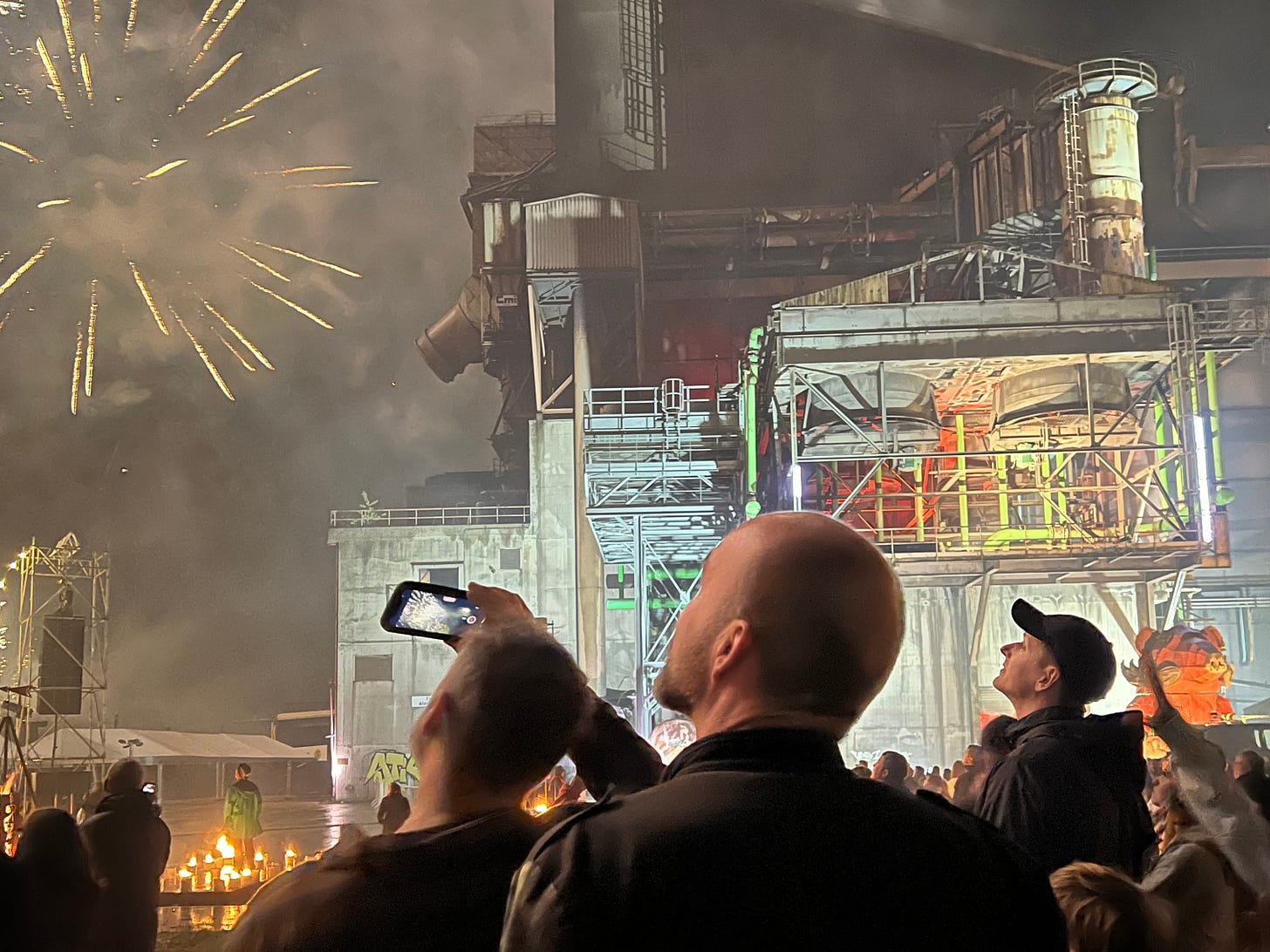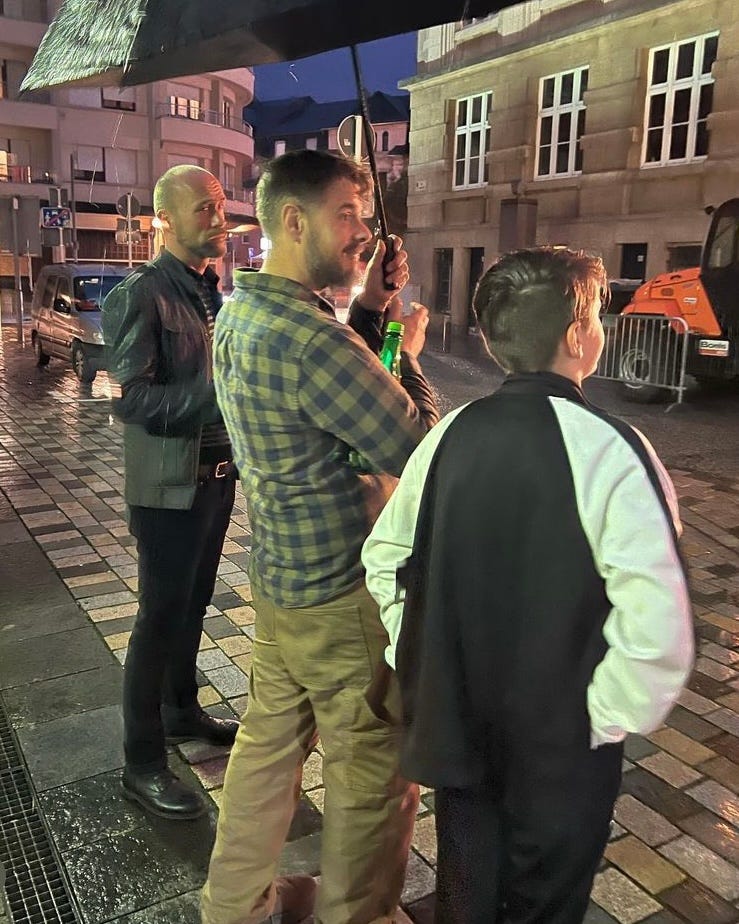The Art of Excess and the Excess of Art
Fireworks, ritual, and the "accursed share" (a photo and video essay)
(This essay is best viewed either on the website or in the app, rather than by email)
It seems every day I get another reminder of how beautifully fortunate I am.
A few years ago, after fleeing an abusive marriage in France, I found myself in Luxembourg. My sister had moved there from the United States for work, and she had an extra room for me to stay in while I tried to recover my rather broken soul. A few months later, I met a man who’d been in a similar situation. Neither of us wanted a relationship after all else we’d been through and told each other that. That made it “safe” to date each other, so we did.
Less than two months after meeting, news of a plague spread across the world, shutting down all travel and right of movement here. He made a wild suggestion: since it would be illegal for us to meet with the country locked-down, he invited me to stay with him. We’d really only had just met, and were both quite broken from what all came before, yet…why not?
If you’ve been reading me for awhile, you already know how this unfolded.
A month after the lock-downs ended, we each had to travel to France, to different places. I needed to return to Rennes to meet a lawyer for my divorce. He had to travel to Toulouse to meet a group of artists for an event he was co-ordinating. That group is called La Machine, a collective of artisans who make massive mechanical fantasy machines for events. After that trip, he asked me to live with him permanently. I said yes.
This weekend, some 28 months later, I got to see the results of his meeting with those artists.
That’s Felix, the boar. Along with two other wooden machines (Giacomo the bear and Barbara the mouse), he appeared for the city of Esch-sur-Alzette’s “Nuit de la Culture” celebration. There were several such nights this year, because the city held one of the rotating titles of European Capitol of Culture for 2022. In fact, almost every weekend there was some sort of massive event. Last weekend, there was an outdoor performance designed by the artistic director of Cirque du Soleil in front of the de-commissioned blast furnace of a steel factory.
That event was wild and rather beautiful, written and choreographed to tell the history of the city’s early industrialization due to steel manufacture and then, up to the present, its attempts to recover from its de-industrialization through developing its artistic and cultural aspects.
While part of a completely separate event, the reason for those machine animals is related. A children’s story written to accompany them tells of a mouse who has wings and doesn’t know why. It’s a new tale, borrowing elements from older stories and local myths. Barbara the mouse (named as a nod to the patron saint of miners, steelworkers, and all who deal with fires and explosions, Saint Barbara) meets a boar (the sacred animal of the Ardennes, and also of Arduinna and of Freyja) and a bear (named Giacomo because the Italian miners who migrated here were called “bears” since they were dark and hairy) who knew her mother. Both had worked as miners with her, and had seen her saving the eggs of caterpillars from destruction when the forests were clear cut and the mines were dug.
One night, Barbara’s mother met a night butterfly (papillon de nuit; that is, a moth), who thanked her for her kindness and danced with her in the sky. Barbara the mouse was the offspring of that dance, which is why she has butterfly wings.
The event for the three machine animals lasted several hours. Three spots in the city were designated as meeting points where one of them would arrive. My sister, brother-in-law, and nephews came with us, and we let the kids choose which they’d like to meet up with. They chose the boar—which of course their druid uncle was pretty damn happy with.
From those meeting points, we paraded through the rain to the same de-commissioned steel factory grounds as the event from the previous weekend. Torches were distributed (yes—even to kids; Europeans are much less overbearing about children and fire than Americans…), and though it rained heavily and the procession was slow, I’d never seen so many people in such a happy, expectant mood.
None of the public knew what was coming at the end; my husband did and told me a little bit, but even knowing what was coming couldn’t prepare me.
The three machine animals and the humans parading with them met up finally into an otherworldly space lit by torches, braziers, and even a large iron rotating wheel of fire (basically, a flaming Ferris wheel).
The story of Barbara’s mother meeting with the moth then was re-enacted by hundreds of people dancing in a circle in front of the animal machines. In the story, Barbara then realizes she can fly as well, and takes to the air as she finally understands who she really is.
That’s when the several thousand of us who’d endured the previous rain found ourselves standing in the middle of this, just as the moon came out from the clouds:
The video is a little over six minutes long, but I highly recommend watching it, especially with sound. I filmed it specifically for you, after all, choosing to be a little less present fumbling with a camera screen so you could watch it also.
For those who don’t or cannot, it’s a 360 degree fireworks display representing Barbara’s flight into the air. Explosions were everywhere you looked, including above a large water tower that served as a canvas for renowned light artist Miguel Chevalier’s projection.
I’ve seen fireworks many more times than I can count (I’m American, after all: blowing up things is the US national sport), but I’d never seen anything so perfect. In fact, I cried, as did my sister, my husband, and I suspect most of the crowd.
Torches, burning braziers, sparks in the sky, music, processions with effigies of animals—though there was nothing “explicitly” pagan about this event, it would be wrong to call it anything but. It’s always what I’ve thought of as paganism, anyway, the communal sort, the ritual sort.
The “Accursed Share”
To be clear, it was of course an event of “excess.” Apparently there’s already criticism here in Luxembourg about the fireworks show (not of course by anyone who was actually there). Not “eco” enough, too gaudy, too wasteful, too loud, too disruptive.
On the other side of the ocean, Americans, especially the “enlightened” sort, are currently engaged in one of their own yearly rituals. That’s the ritual of everyone telling everyone else that Burning Man is a bad, immoral, wasteful, irresponsible nightmare that no one should ever have gone to. Too polluting, too much CO2 emissions, too many rich people, too much trash, too much meaningless celebration.
I’ve never been to Burning Man, nor do I imagine the majority of its critics have, either. I was one of those bitter detractors myself, decrying all those heavy gas-guzzling vehicles and vapid colonizers on sacred land pretending to be enlightened. It’s quite easy and very comforting to criticize something you weren’t part of, just as it’s very satisfying to find apparent confirmation that the “cool thing” you didn’t go to wasn’t really as cool as it promised to be. That way, you need never feel you missed out.
Of course, events like Burning Man cost participants a lot of money. The events here were all free, funded fully by the government. And there are other differences, certainly, but there’s a larger point that applies to any sort of communal ritual—new or ancient—which gets criticized for being “wasteful.”
The philosopher Georges Bataille suggested that every society always produces an “excess” that it must destroy. He called this the “accursed share,” and in ancient and non-capitalist societies it is usually destroyed through ritual and sacrifice.
Art is itself excess: no one “needs” paintings, statues, music, colorful clothing, dance, or jewelry. While we might try to justify them through theories about social or psychological needs, the very point of art is that it a completely unnecessary thing that we understand is somehow nevertheless essential to our existence.
Fireworks are a perfect example of the accursed share. They are meant to explode, to be destroyed. Only by destroying them do they create beauty, and that beauty is always ephemeral. Even if I’d had the ability to film every firework exploding in all directions around me, I’d never be able to replicate for you exactly how it felt to be surrounded by such beautiful sacrificial destruction.
Bataille argued that holding on to the excess in society too long leads to catastrophic and violent destructions of that accursed share, because it must always be destroyed somehow. Luxury and art are both normal ways of destroying it, but when those routes are blocked the sacrifice becomes human (war, genocide, or in ancient times ritual human sacrifice and self-destruction).
What’s needed is not less-wasteful art and ritual, but rather more of it. The core religious drive of capitalism is consumption of excess, rather than its destruction. We are compelled to over-eat, to over-buy, to accumulate and try to store up the excesses of production. Capitalist market forces would turn us all into obese hoarders with no more room in our bodies or homes for the excesses it pushes upon us.
Art and ritual are the only solutions to that excess. All that “wasted” money on art and public ritual is what we’re supposed to do with the excess, what we have to do with it.
Of course it’s completely unnecessary, excessive, and wasteful: that’s the reason art exists.













Social utility is way oversold these days as a benchmark for human value. This week, with the Queen passing away, the punditry has gone into overdrive on the subject. But social utility itself is a fluid concept, subject to the utterly illogical whims of the observer. Lenin despised Tsardom, but was it the logical conclusion of his reams of theories, or simply because his brother was murdered by the Tsar's father? As a taxpayer, I'd much rather finance fireworks and Burning Man than the burning of Southeast Asian villages or the miles of mothballed aircraft at the Tucson Boneyard. But with this comment, I'm probably showing my age. Bring on the excess, the zanier and more mythological the better. Pure fun is so underrated.
Thank you Rhyd from Oregon- who knows, maybe we and the other creatures that exist are the product of a late night Art project by some Entity....when you see some of the creatures it isn't hard to imagine!